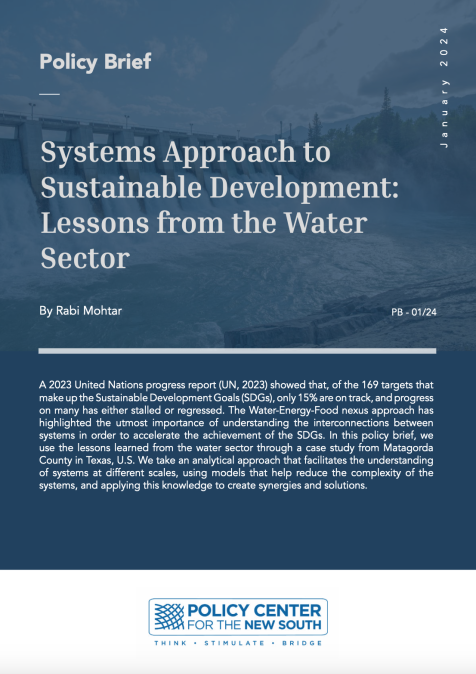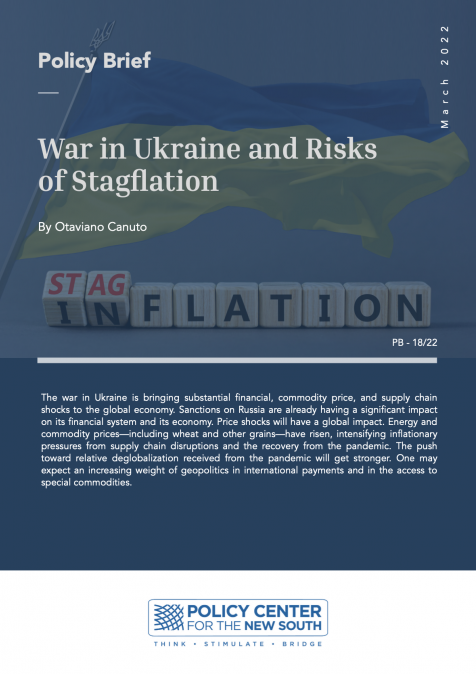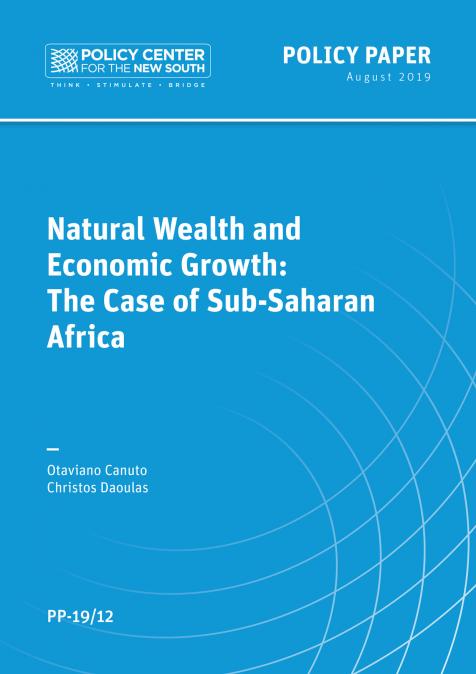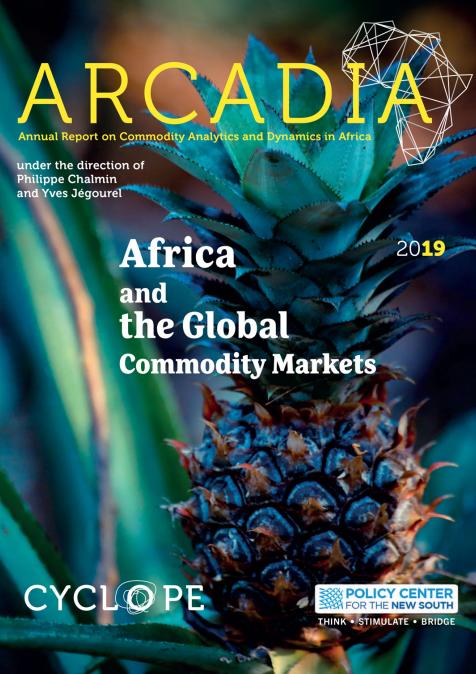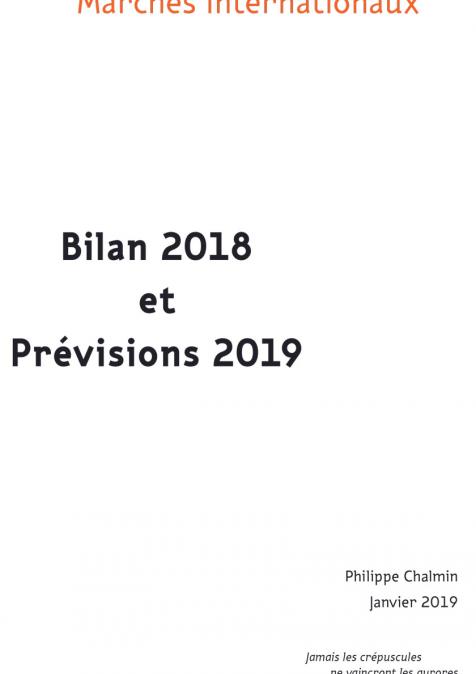Publications /
Policy Brief
A 2023 United Nations progress report (UN, 2023) showed that, of the 169 targets that make up the Sustainable Development Goals (SDGs), only 15% are on track, and progress on many has either stalled or regressed. The Water-Energy-Food nexus approach has highlighted the utmost importance of understanding the interconnections between systems in order to accelerate the achievement of the SDGs. In this policy brief, we use the lessons learned from the water sector through a case study from Matagorda County in Texas, U.S. We take an analytical approach that facilitates the understanding of systems at different scales, using models that help reduce the complexity of the systems, and applying this knowledge to create synergies and solutions.
INTRODUCTION
The Sustainable Development Goals (SDGs), as established in 2015, are more than halfway to the target completion deadline of 2030. The 17 interconnected SDGs are an ambitious attempt to create a more human-centric, planet-protective approach to growth. A 2023 assessment of progress towards the SDG targets (UN, 2023) showed that there has been only very modest movement forward, with a mere 15% of the targets on track. It is clear, as shown in Figure 1, that progress on most targets has been slow and, in many cases, stagnation or regression was recorded globally. If we focus on SDG 6, related to water and sanitation, none of the targets have been met, and progress on nearly 40 percent is stalled or regressing.
While the reasons for this lack of progress vary greatly and depend on local and regional circumstances, it is important to note that one of the big challenges in achieving the ambitious agenda of the SDGs is the lack of coherence between goals and the competition that arises between targets. It is easy to disregard the interlinkages and trade-offs between goals and targets, creating in some cases inadvertent competition instead of synergies. This is where systems thinking can play a very important role. Building this coherence requires analytics that quantifies the trade-offs and quantifications of cost/benefits of management scenarios (Daher and Mohtar, 2021).
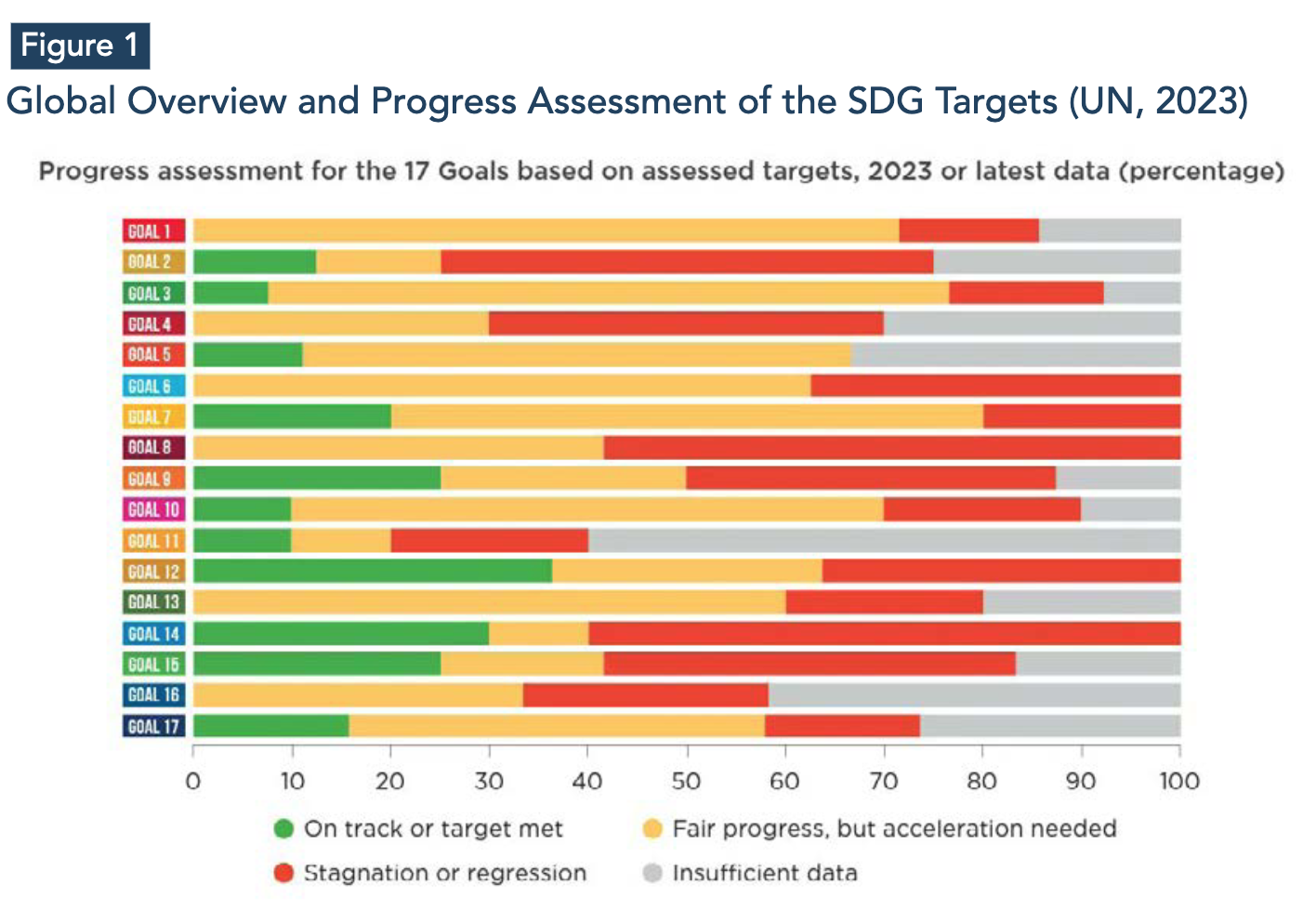
While national governments usually set national goals, it is local governments that oversee implementation and strategies to monitor progress. This horizontal coherence requires effective institutional agreements that create synergies between all the sectors involved. Institutions must consider national circumstances, including the political environment, national policy frameworks, actors and stakeholders, private-public-academic partnerships, budgeting, and planning processes. Localizing the implementation of SDGs must also include the involvement of civil society, including the most vulnerable and marginalized (SDG Helpdesk, 2020).
As governments attempt to align their social, environmental, and economic policies to achieve the SDGs, there is much to be done to involve stakeholders and sectors together so that policies are coherent. In attempting to achieve the 17 SDGs all at once, there have to be trade-offs between the different sectors involved, in order to create opportunities and synergies. The social-economic-environmental nexus is complex; from a systems perspective, the focus is on understanding the needs and interests of each sector, and on creating tools to productively manage these conflicts in ways to promote sustainable development (Fischer, 2016).
Water is at the center of sustainable development. Water systems exist within a bigger system of interactions covering food, energy, health, education, sustainable diets, and other areas. SDG 6, as formulated by the United Nations, focusing on water, has a deep connection with livelihood, health, food security, hunger, participation, and cooperation. A systems perspective on water-resources management is now emerging as a way to capture these interlinkages.
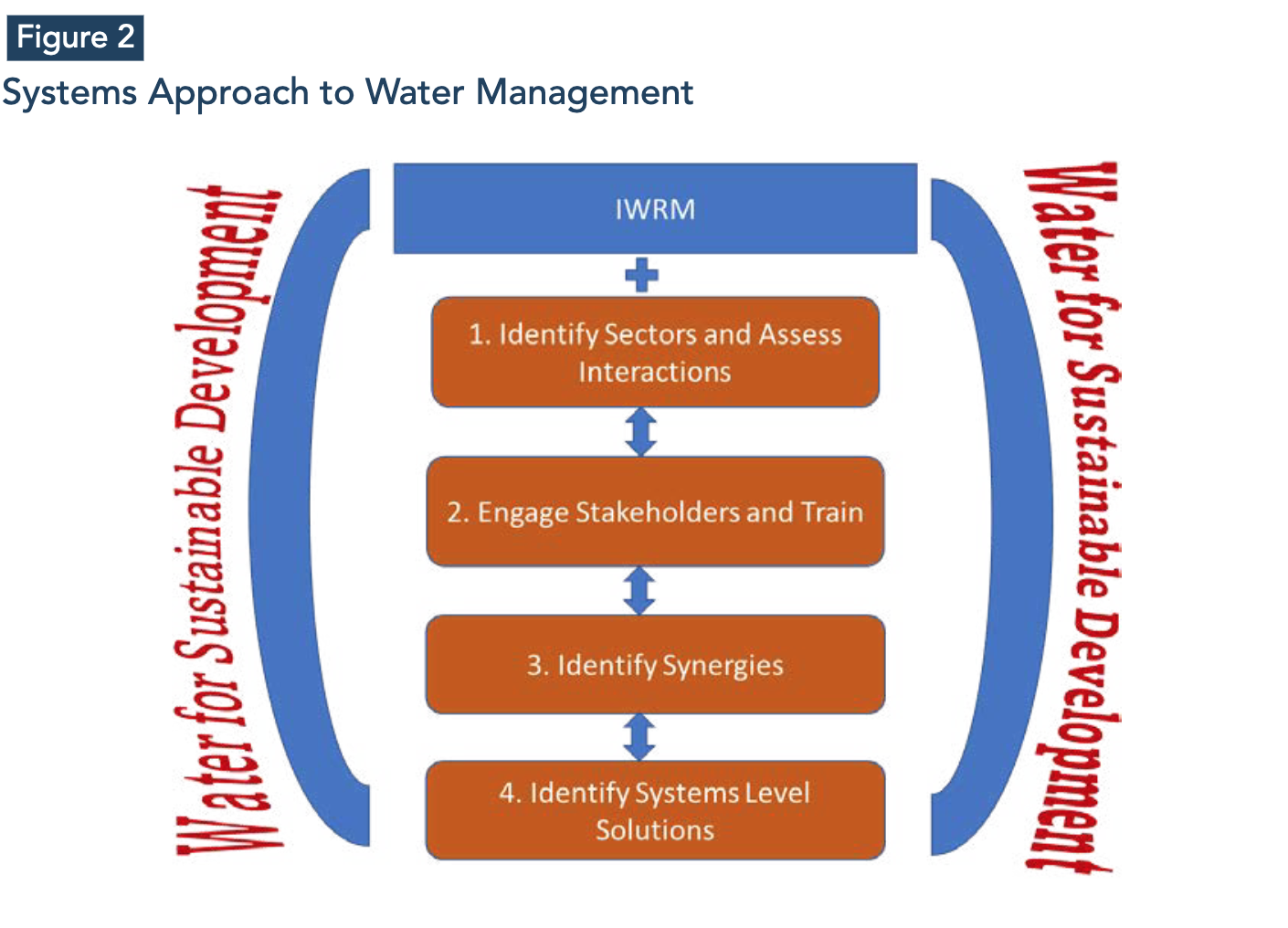
Since water challenges cross boundaries and are not only bound to the water sector, but it is also imperative to look at a larger framework of water systems. A new vision for Integrated Water Resources Management (IWRM) was launched in 2023 at the IWRA World Water Congress in Beijing, China1. This new framework looks at water as a resource that involves water for people, water for food, water for nature, water for industry, water for peace, for education, for health, for equity, and for energy. Figure 2 shows this new approach to water management. These multiple dimensions of water have placed it at the crossroads of systems thinking that aims at sustainability. The challenge is that up until now, frameworks have not captured these interactions. In this new vision, the report (WWC, 2023) talks explicitly about a roadmap showing how to identify stakeholders, how to identify solutions that may be outside the water sector, how to define what we call the trade-offs, and how to identify synergies and solutions that outline water challenges along with the sustainable development challenge. This policy brief sheds a light on this new system of systems approach and presents an application through a case study from Matagorda County, in Texas.
Case Study: Mitigating Water Stress in Matagorda County, Texas
Matagorda County in Texas, neighboring the city of Houston, is traditionally an agricultural community. With its abundant water resources, rice production has been a major part of Matagorda’s economy. Nonetheless, with the growing population in the neighboring metropolitan area of Houston, major challenges in water use and distribution have arisen. Besides its growing population, Houston, as a center of the oil industry, claims to be the ‘energy capital of the world’. That also includes a nuclear energy power plant that requires massive amounts of cooling water to generate electricity.
Figure 3 shows land use in the area. It is clear from the green areas that significant agricultural activities still take place in some areas around Houston, generating competition for water between the metropolitan area of Houston, agriculture, and the energy sector. This calls for synergy between the potentially competing sectors. Using the water-energy-food nexus approach, which is a system of systems, we generated potential water-related infrastructure solutions to help alleviate water stresses in Matagorda County, using the Nexus Tool as a mean to quantify tradeoffs.
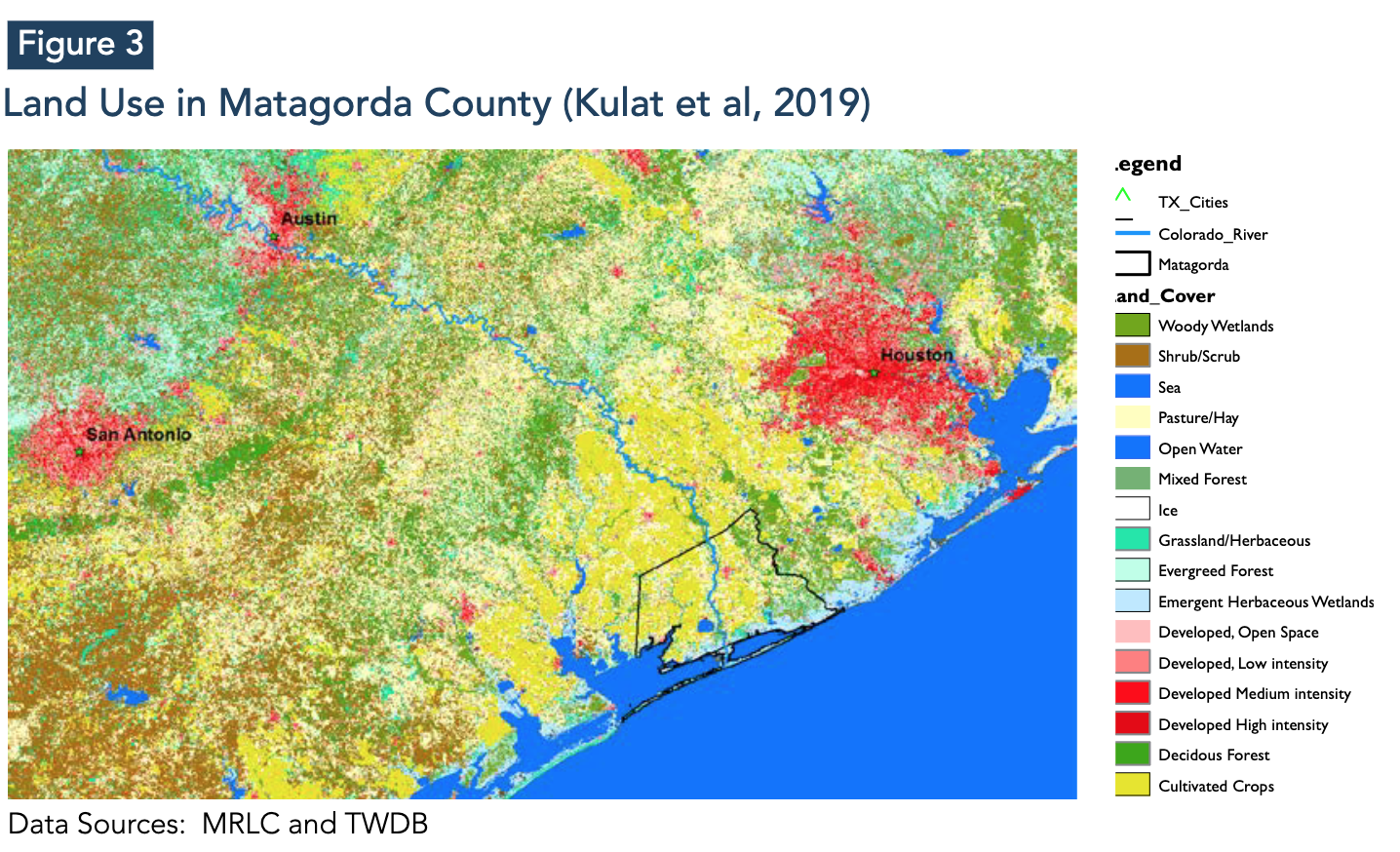
This is the kind of science-based decision and policy making, to help identify system level feasible interventions. Through complex analytics that allow us to investigate a complete portfolio of food, water, and energy within the study area, we can quantify the interactions between these sectors. We looked at various scenarios that focus mainly on water-energy- food resources infrastructure. In other words, using the Nexus Tool 2.0, we looked at how the resources infrastructure that is built to synergize water-energy-food system can help us identify better solutions that can maximize the county’s economic development and resource allocation. The use of this analytical tool allowed us to analyze and assess possible solutions to guide future investment to guarantee access to water for agricultural, municipal, and industrial use, and also to meet the intensive demands of the energy sector.
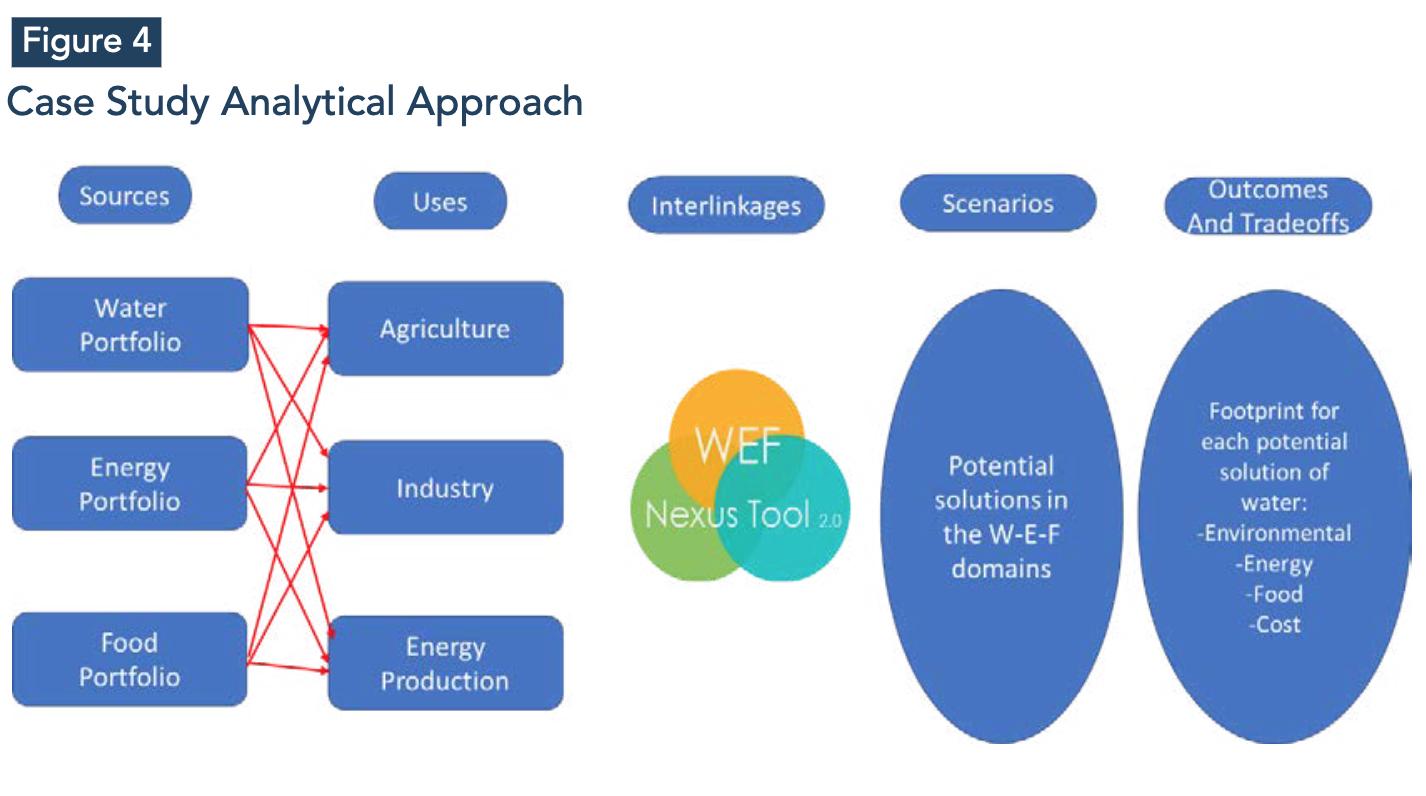
The base scenario, which is business as usual as it exists today, was compared with possible alternative interventions. We investigated the improvement of the water-conveyance system to reduce water loss from farm irrigation (irrigation efficiency). Another option was building a reservoir that allows the storage of run-off water. A third scenario suggested an infrastructure solution, which is building a desalination plant for brackish water, in the context of the county’s closeness to the coast. Another infrastructure solution that was investigated was the building of a water treatment facility for reuse. For the energy sector, we looked at the use of seawater for cooling in addition to building a solar farm for energy production. With this kind of Nexus approach, we provide a platform to help choose the most suitable combination of water, energy, and food infrastructure to ensure that there is no interruption to any of the businesses ( energy water use, domestic municipal use, and industrial outdoor municipal water for mining and processing). As for the farming sector, which is the base economy for Matagorda County, we also see a lot of benefits, despite the infrastructure costs involved. Last but not least, because agriculture is a foundation for the economy in this county, we believe that this not only trickles down to agriculture, but it would help the entire economy of the county, with overall savings of primary resources and less environmental damage when using these approaches.
Implications of a Systems View for Resource Management
Considering the SDGs agenda and some of the frontier issues that should be tackled beyond 2030 there has been some progress, but climate agenda targets are certainly not being met. The SDGs are the ultimate nexus, where the interaction between these goals is a major challenge that requires close consideration.
We are convinced that the way the SDGs were designed and established set the stage for disciplinary approaches that, by the nature of the disciplines and the way they are governed, bring about competition between them in terms of targets and how they are achieved. So, the SDGs are the outcomes of disciplinary agendas. The lack of progress in achieving the SDGs can be attributed partly to their disciplinary design. We believe this has set the stage for conflict between the goals and a lack of integration. One of the missing links with the SDGs is how they can be made to work together in synergy, rather than in competition. Meeting the food security goals infringes on water goals. Meeting the water goals infringes on the energy and other goals. This has created divergence in progress towards the goals. Hence, we must look at end points and at integrative outcomes, integrative metrics that allow convergence and not divergence. Overall, there is a lack of governance to enforce the SDGs, so it is mostly national plans that set specific actions to meet those targets, but even the national plans of one sector sometimes infringe on the national plans of other sectors.
We strongly believe that the lessons learned must focus on integrative endpoint metrics that allow for creativity and innovation in terms of synergy, and do not cause conflict between these goals. Meeting one goal should not jeopardize meeting sustainable goals in other sectors. Hence, water governance must take into account the multitude of interests and framings of competing sectors, whether they are technological, political, environmental, or social.
Water is at the center of sustainable development. Water interventions have multiple natures, whether technological, policy, or behavioral. At the core of these interventions is personal choice to manage water demand and supply. These choices involve multiple stakeholders, policy makers, technology providers, individuals among others. All of these stakeholders should be empowered to make the right and responsible decisions. As an example, educators must develop the right training and curriculum to bring awareness to these issues and teach the tools for students to make informed decisions. The policies for educational reform take years and it is the responsibility of educators to develop and update training material to make sure students are informed and empowered to make choices. We all have the responsibility to empower the younger generations to make the right choices; whether a stakeholder is working with industry, or government, or civil society, we must create opportunities to empower people to do the right thing. Everyone counts.
References
- Daher B., Mohtar R.H. (2021) Water-Energy-Food Sustainable Development Goals in Morocco. In: Leal Filho W., Azul A.M., Brandli L., Lange Salvia A., Wall T. (eds) Clean Water and Sanitation. Encyclopedia of the UN Sustainable Development Goals. Springer, Cham. doi: 10.1007/978-3-319-70061-8_133-1.
- Fischer, J and Rucki, K (2016). Re-conceptualizing the Science of Sustainability: A Dynamical Systems Approach to Understanding the Nexus of Conflict, Development and the Environment. Sustainable Development, Volume 25 Issue 4. Pages 267-275. https://doi.org/10.1002/sd.1656
- Kulat, M.I., Mohtar, R.H., Olivera, F. (2019) Holistic Water-Energy-Food Nexus for Guiding Water Resources Planning: Matagorda County, Texas Case. Front. Environ. Sci. 7, 3. doi: 10.3389/fenvs.2019.00003 open access
- SDG Helpdesk, 2020. “SDG Coordination Mechanism”. Accessed online at https://sdghelpdesk. unescap.org/knowledge-hub/thematic-area/sdg-coordination-mechanism
- United Nations, 2023. The Sustainable Development Goals Progress Chart 2023. Accessed online on December 2023 at https://unstats.un.org/sdgs/report/2023/progress-chart/
- WWC, 2023. World Water Council Task Force on IWRM (Rabi Mohtar, Chair) . Opening Up Integrated Water Resource Management to Include Energy, Food, Health, and Education. download

